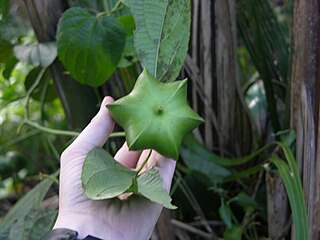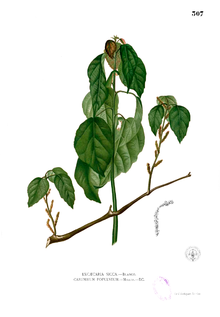
Euphorbia is a very large and diverse genus of flowering plants, commonly called spurge, in the family Euphorbiaceae. "Euphorbia" is sometimes used in ordinary English to collectively refer to all members of Euphorbiaceae, not just to members of the genus.

Phyllanthaceae is a family of flowering plants in the eudicot order Malpighiales. It is most closely related to the family Picrodendraceae.

The family Pandaceae consists of three genera that were formerly recognized in the Euphorbiaceae. Those are:

The Acalyphoideae are a subfamily within the family Euphorbiaceae with 116 genera in 20 tribes.

The Crotonoideae (crotonoids) is a subfamily within the family Euphorbiaceae. This subfamily contains many plants with purgative properties, such as Croton tiglium and Jatropha curcas.

The Euphorbioideae are a subfamily within the family Euphorbiaceae.

Aleuritideae is a tribe of the subfamily Crotonoideae, under the family Euphorbiaceae. It comprises 6 subtribes and 14 genera.

Codiaeae is a tribe of the subfamily Crotonoideae, under the family Euphorbiaceae. It comprises 15 genera.

The Acalypheae is a tribe of the subfamily Acalyphoideae, under the family Euphorbiaceae. It comprises 12 subtribes and 32 genera.

Omphalea is a plant genus of the family Euphorbiaceae first described as a genus in 1759. It is native to tropical parts of the Americas, the West Indies, Asia, Australia, and Africa.

Plukenetieae is a tribe of plant of the family Euphorbiaceae. It comprises 3 subtribes and 14 genera. Tribe Plukenetieae (Benth.) Hutch. is a diverse pantropical lineage of ca. 17 genera and 350 species of twining vines and lianas, scandent to erect perennial herbs and subshrubs, and rarely shrubs and small trees.

Hippomaneae is a tribe of flowering plants of the family Euphorbiaceae. It comprises 2 subtribes and 33 genera.
Aparisthmium is a plant genus of the family Euphorbiaceae first described as a genus in 1840. It contains only one known species, Aparisthmium cordatum, native to South America and Costa Rica.
Conceveiba is a plant genus of the family Euphorbiaceae, first described as a genus in 1775. It is native to South America and Central America.
- Conceveiba guianensisAubl. - Brazil, Peru, Bolivia, Ecuador, Colombia, Venezuela, 3 Guianas
- Conceveiba hostmaniiBenth. - Guyana, Suriname, Amazonas State in Brazil
- Conceveiba krukoffiiSteyerm. - Venezuela, French Guiana, NW Brazil
- Conceveiba latifoliaBenth. - Colombia, Venezuela, Peru, Amazonas State in Brazil
- Conceveiba martianaBaill. - Venezuela, French Guiana, NW Brazil, Colombia, Ecuador, Peru, Bolivia
- Conceveiba maynasensisSecco - Loreto in Peru
- Conceveiba parvifoliaMcPherson - Panama, NW Colombia
- Conceveiba pleiostemonaDonn.Sm. - Costa Rica, Nicaragua, Colombia, Venezuela
- Conceveiba praealta(Croizat) Punt ex J.Murillo - NW Brazil
- Conceveiba ptariana(Steyerm.) Jabl. - S Venezuela
- Conceveiba rhytidocarpaMüll.Arg. - Colombia, Ecuador, Peru
- Conceveiba santanderensisJ.Murillo - NW Colombia
- Conceveiba terminalis(Baill.) Müll.Arg. - Venezuela, Guyana, Suriname, NW Brazil, Colombia, Peru
- Conceveiba tristigmataJ.Murillo - Colombia, Venezuela, NW Brazil
Benoistia is a genus of shrubs or trees of the spurge family (Euphorbiaceae) and the monotypic subtribe Benoistiinae. It was first described as a genus in 1939. The entire genus is endemic to Madagascar. It is dioecious.
- Benoistia orientalisRadcl.-Sm. - N + E Madagascar
- Benoistia perrieriH.Perrier & Leandri - Madagascar
- Benoistia sambiranensisH.Perrier & Leandri - N Madagascar
Herbert Kenneth Airy Shaw was a notable English botanist and classicist.
Käthe Hoffmann was a German botanist who described many plant species in New Guinea and South East Asia including Annesijoa novoguineensis. She was a professor at Breslau, German Empire, and made a significant contribution to botany. In one study, she was found to have co-authored or authored 354 land plant species, the sixth-highest number authored by any female scientist. As of May 2020, Plants of the World Online lists 439 accepted genera and species which include Käthe Hoffmann in the authority, in some capacity.

Euphorbiaceae, the spurge family, is a large family of flowering plants. In English, they are also commonly called euphorbias, which is also the name of the type genus of the family. Most spurges, such as Euphorbia paralias, are herbs, but some, especially in the tropics, are shrubs or trees, such as Hevea brasiliensis. Some, such as Euphorbia canariensis, are succulent and resemble cacti because of convergent evolution. This family has a cosmopolitan global distribution. The greatest diversity of species is in the tropics; however, the Euphorbiaceae also have many species in nontropical areas of all continents except Antarctica.

Aecidium is a genus of rust fungi in the order Pucciniales.

Peraceae Klotzsch is a family of flowering plants in the eudicot order Malpighiales. The family was segregated from the Euphorbiaceae by Johann Friedrich Klotzsch in 1859, and its uniqueness was affirmed by the Royal Botanic Gardens, Kew's Euphorbiaceae expert, Airy Shaw.















